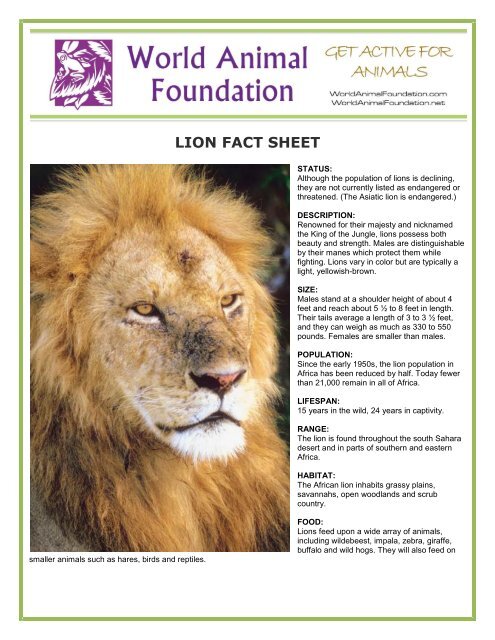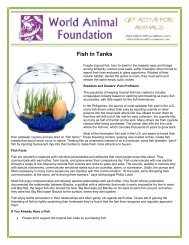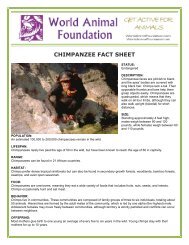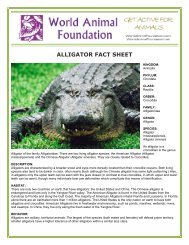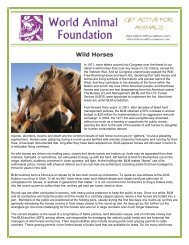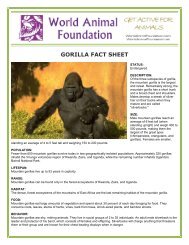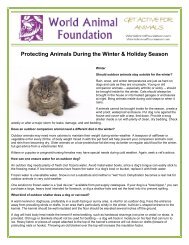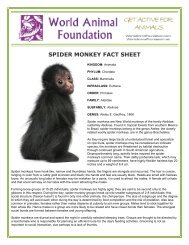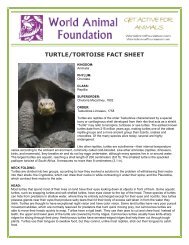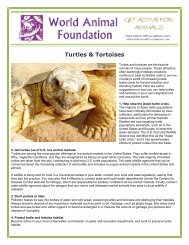LION FACT SHEET - World Animal Foundation
LION FACT SHEET - World Animal Foundation
LION FACT SHEET - World Animal Foundation
You also want an ePaper? Increase the reach of your titles
YUMPU automatically turns print PDFs into web optimized ePapers that Google loves.
smaller animals such as hares, birds and reptiles.<br />
<strong>LION</strong> <strong>FACT</strong> <strong>SHEET</strong><br />
STATUS:<br />
Although the population of lions is declining,<br />
they are not currently listed as endangered or<br />
threatened. (The Asiatic lion is endangered.)<br />
DESCRIPTION:<br />
Renowned for their majesty and nicknamed<br />
the King of the Jungle, lions possess both<br />
beauty and strength. Males are distinguishable<br />
by their manes which protect them while<br />
fighting. Lions vary in color but are typically a<br />
light, yellowish-brown.<br />
SIZE:<br />
Males stand at a shoulder height of about 4<br />
feet and reach about 5 ½ to 8 feet in length.<br />
Their tails average a length of 3 to 3 ½ feet,<br />
and they can weigh as much as 330 to 550<br />
pounds. Females are smaller than males.<br />
POPULATION:<br />
Since the early 1950s, the lion population in<br />
Africa has been reduced by half. Today fewer<br />
than 21,000 remain in all of Africa.<br />
LIFESPAN:<br />
15 years in the wild, 24 years in captivity.<br />
RANGE:<br />
The lion is found throughout the south Sahara<br />
desert and in parts of southern and eastern<br />
Africa.<br />
HABITAT:<br />
The African lion inhabits grassy plains,<br />
savannahs, open woodlands and scrub<br />
country.<br />
FOOD:<br />
Lions feed upon a wide array of animals,<br />
including wildebeest, impala, zebra, giraffe,<br />
buffalo and wild hogs. They will also feed on
BEHAVIOR:<br />
The only social member of the cat (Felidae) family, lions live in<br />
large groups called "prides," consisting of about 15 lions. Related<br />
females and their young make up the majority of the pride. A<br />
single male, or sometimes a small group of two to three males, will<br />
join a pride for an indefinite period, usually about three years or<br />
until another group of males takes over. Females do almost all of<br />
the hunting. They are mainly nocturnal and work in teams to stalk<br />
and ambush prey. A lion can run for short distances at 50 miles<br />
per hour and leap as far as 36 feet. They are also territorial, males<br />
roar and use scent markings to establish their domain.<br />
OFFSPRING:<br />
A female gives birth to litters averaging three to four cubs. If the<br />
entire litter dies, she will mate again within a few days. They begin<br />
hunting at 11 months and remain with their mother for at least two<br />
years.<br />
CAPTIVITY:<br />
Performing captive wildlife – elephants, lions, tigers, bears,<br />
baboons, monkeys, camels, llamas - all endure years of physical<br />
and psychological pain and suffering in traveling acts to "entertain"<br />
an uninformed audience. <strong>Animal</strong>s used in the circus and other<br />
traveling acts travel thousands of miles each year without water, in<br />
railroad cars or trucks not air conditioned in summer or heated in<br />
winter.<br />
In the wild, large cats roam for miles each day; they hunt for food,<br />
sleep in the sun and lead a fairly solitary existence. Exotic cats<br />
used in the circus are allowed none of these behaviors. They live<br />
and travel in small cages in close confinement with other cats. They have little room to move around and are never<br />
provided with any environmental enrichment.<br />
Cats used in the circus are trained by inherently cruel and dominating methods to force them to perform tricks that are<br />
unnatural and undignified. Exotic cats are often whipped, choked, and beaten during their training sessions. To force a cat<br />
to stand on her hind legs, her front paws are often burned with cigarette lighters. To make the cats used in the circus run<br />
"enthusiastically" into the circus arena, they are often prodded with pipes or frightened by loud noises to make them<br />
appear excited to perform.<br />
Despite their professed concern for animals, zoos remain more "collections" of interesting "items" than actual havens or<br />
simulated habitats. Zoos teach people that it is acceptable to keep animals in captivity, bored, cramped, lonely, and far<br />
from their natural homes.<br />
Zoos claim to educate people and preserve species, but they frequently fall short on both counts. Most zoo enclosures are<br />
quite small, and labels provide little more information than the species' name, diet, and natural range. The animals' normal<br />
behavior is seldom discussed, much less observed, because their natural needs are seldom met.<br />
Many animals who naturally live in large herds or family groups are often kept alone or, at most, in pairs. Natural hunting<br />
and mating behaviors are virtually eliminated by regulated feeding and breeding regimens. The animals are closely<br />
confined, lack privacy, and have little opportunity for mental stimulation or physical exercise, resulting in abnormal and<br />
self-destructive behavior, called zoochosis.<br />
Zoo babies are great crowd-pleasers, but what happens when babies grow up? Zoos often sell or kill animals who no<br />
longer attract visitors. Deer, tigers, lions, and other animals who breed often are sometimes sold to "game" farms where<br />
hunters pay for the "privilege" of killing them; some are killed for their meat and/or hides. Other "surplus" animals may be<br />
sold to smaller, more poorly run zoos or to laboratories for experiments.<br />
THREATS:<br />
Loss of habitat to population growth and agricultural expansion as well as hunting and poisoning by livestock ranchers.


